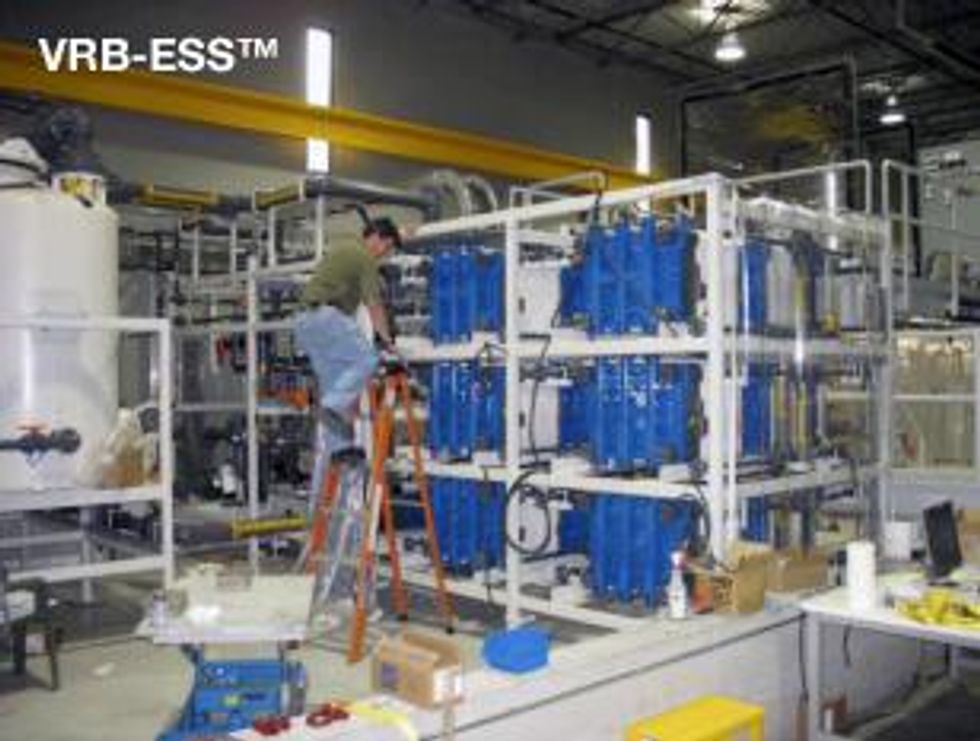Vanadium redox battery are gaining the attention of commercial operations as well as governments as a large scale energy storage solution.

By Damon van der Linde – Exclusive to Vanadium Investing News
As demand for renewable energy sources grows, so will the need to store that energy. Because both wind and solar power do not provide a consistent flow of electricity, technology like the vanadium redox battery is gaining the attention of commercial operations as well as governments, projecting a push in future demand for the mineral.
“The overall acceptance of energy storage globally is becoming more and more, and that’s going to boost the batteries that can cycle and do things that only we can do,” said Tim Hennessy, President of Prudent Energy, a United States-based company that designs and manufactures vanadium redox battery (VRB®) energy storage systems.
According to the Vanadium International Technical Committee (VANITEC) the vast majority of vanadium is used to strengthen steel. However, the use of vanadium in battery technologies, like the VRB®, is growing.
What makes vanadium an ideal mineral for battery technology is that as a transition metal four energy states can be created within the same material. Vanadium is used in the electrolyte state in VRB®, which are a type of flow battery. The electrolyte is the element that stores the energy and that flows through or past an electrode. This movement of electrons or protons across a membrane allows heat to be taken out of the battery and separates the energy storage from the power.
Hennessy explained that one advantage of a flow battery is that it can be scaled up to the desired size without having to increase the power output, as with a lithium battery. Controlled scaling is ideal for large-scale applications like powering grids, as the VRB is limited only by space in its storage capacity.
“Another advantage of the VRB® is that unlike most other battery technologies, it can be repeatedly cycled without affecting the lifespan.” said Hennessy.
The downside of this is that the VRB has a lower energy density than other battery formats, meaning that Prudent Energy’s current products are focused more on commercial applications.
“Its applications are limited to places where you have sufficient space, you can’t jam it into your computer or a car, and you can’t jam it into a very small space down in the basement necessarily,” said Hennessy. “It is primarily focused on places that you have space like wind farms and solar, or companies where they have larger loads.”
Hennessy projects an increase in demand for vanadium in batteries, equaling 10-15 percent of the mineral’s total use in the next three years.
“Demand for vanadium in going to be increasing, but having said that, vanadium is pretty plentiful. The volume of supply now is limited only to manage the price and that is used mainly in the steel industry,” he said.
Energizer Resources (CVE:EGZ) is one company that is planning to produce vanadium at its Green Giant project in Madagascar by the end of 2014. What makes this project unique is that because it is sediment-hosted rather than magnetite hosted, it will be producing vanadium as a primary product – ideal for the demands of the battery industry.
“High-purity and battery-grade are two different things. The steel industry requires a high purity vanadium, but it’s not a battery grade,” said Brent Nykoliation, Vice President of Business Development at Energizer Resources.
Nykoliation said that projects like Energizer’s are going to be needed in the future as the battery industry grows and other vanadium producers who primarily target the steel industry must perform additional processing to remove impurities from their product.
“What they fail to tell people is that if you produce this vanadium for the battery world, it needs to be further processed. This means additional operating costs because you have to remove the contaminants,” said Nykoliation. “It’s a significant cost jump to go from a normal vanadium product to a battery-grade product, and then to get an electrolyte.”
Other developments in the vanadium battery market may come from vanadium-charged lithium batteries for use in high-performance technology like electric vehicles, which Nykoliation says are currently in the process of being developed by laboratories in the United States, Germany and Japan.
“All these world-class labs are fast-tracking the vanadium battery development and that makes me feel good – there is a huge untapped market,” said Nykoliation. “There is a technological breakthrough and the tipping point is fast approaching. It’s not if, but when.”